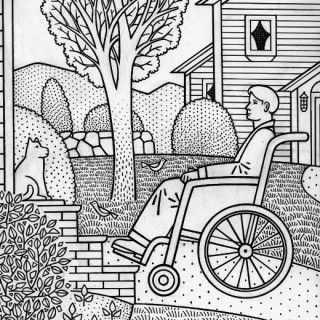See also planner and real estate market researcher Wayne Lemmon’s response to Maisel’s article.
Read an excerpt from this article below. You can download the full article by using the link at the end of the excerpt.
The current housing stock fails to meet the needs and preferences of today’s aging population and those with disabilities. While the lack of affordable housing often attracts attention, much less notice is taken of the shortage of accessible housing. Homes that empower the elderly and people with disabilities are all too uncommon, particularly in the single-family housing market. Many homes are still being built with steps at all entrances and hallways, and doorways that are too narrow for wheelchair users.
With the aging of the baby boomer generation, homes that allow seniors to age in place will become increasingly desirable. Changes in public policy and design practices must begin to prepare for the growing number of seniors who want to age in their own homes. Visitability — an affordable and sustainable design strategy — strives to increase the supply of accessible single-family housing. Its simplicity has led to thousands of open-market homes with basic access across the country.
The Housing Problem and Changing Demographics
The lack of accessible housing most directly impacts people with mobility impairments and the elderly. This includes many with disabling injuries, a number that is increasing dramatically with tens of thousands of wounded Iraq war veterans. But it can also include just about anyone who, at one time or another, has broken a leg, a hip, or had some accident limiting mobility. The design of the house and its entryway can pose serious obstacles, and also hinder many individuals’ ability to remain actively engaged and participate in the community.
A study published by the U.S. Department of Housing and Urban Development emphasized the discrepancy between the need and supply of accessible homes. The research found that over one million elderly homeowners have unmet housing needs that could force them to reluctantly abandon their homes, prematurely move to institutional settings, and reduce their quality of life. …
What is Visitability?

Visitability has emerged as an innovative solution to the shortage of accessible housing. Originating in Europe, the visitability movement was initiated in the United States in 1986 by Eleanor Smith, a disability rights advocate.
Along with her organization, Concrete Change, Smith’s ultimate goal is to make all new homes “accessible enough” for not just the homeowner (or renter), but for a visitor with a disability — hence the use of the word “visitability.” In other words, a visitable home is intended to be a residence for anyone and to provide basic access to everyone. Visitability strives to provide a baseline level of accessibility in all new home construction, in hopes of benefiting the entire population.
A visitable home is any new single-family dwelling unit, duplex, triplex, or townhouse that is intentionally built with at least the following three features:
- One zero-step entrance on an accessible route;
- Doorways that provide at least 32 inches of clearance and wider hallways;
- Basic access to at least a half bath on the main floor.
While the benefits of these features are most essential for a person with mobility impairments to visit or live in a home, they can be invaluable to all of us (as even an otherwise healthy individual may suffer from an unexpected, but temporarily disabling injury). Visitability strives to create an opportunity for all neighbors in a community to socialize, help each other, and interact more effectively. It attempts to break down attitudinal as well as physical barriers to social integration of people with disabilities. …
End of excerpt
You must be logged in or a PlannersWeb member to download this PDF.